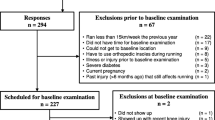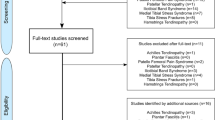Summary
Although exercise results in a number of well documented physical fitness and health benefits, accruing such benefits entails a risk of exercise-related injuries. Musculoskeletal injuries occur frequently among fitness programme participants, runners, athletes, military recruits and others who engage in routine vigorous exercise. The same parameters of exercise (intensity, duration and frequency) that determine the positive fitness and health effects of physical training also appear to influence the risk of injuries. Studies of runners and other physically active groups have consistently demonstrated that greater duration and frequency of exercise are associated with higher risks of injury. However, the sports medicine literature shows little association between exercise intensity and injuries, a finding which may be misleading. The strongest and most consistent association reported exists between greater total amounts of exercise and higher risks of injury. This is not surprising, since the total amount of exercise is the product of the intensity, duration and frequency of exercise. Recent military research confirms the finding that higher volumes of running are associated with higher rates of injury. Furthermore, the study of army recruits suggests that greater amounts of exercise not only result in greater risks of injury, but in some instances may also impart no additional increase in fitness, a finding consistent with an earlier study of civilian runners. Several military studies also demonstrate that those recruits who have been more physically active in the past are less likely to be injured during basic training. These military studies also document a number of other factors, such as older age, smoking, sedentary jobs and lifestyle, high or low flexibility and high arches of the feet, which may contribute to or modify the risks for exercise-related injuries.
In conclusion, the present review suggests that, for activities such as running, specific parameters of exercise may contribute to the overall risk of injuries in rough proportion to their contribution to the total amount of activity performed. Also, better knowledge of the effects of the parameters of training and other factors on the risks of exercise-related injuries is necessary to make more judicious choices about how to best achieve the benefits of exercise and to prevent injuries.
Similar content being viewed by others
References
US Department of Health and Human Services. Public Health Service. Healthy people 2000: national health promotion and disease prevention objectives. Washington DC: US Department of Health and Human Services, 1991
Paffenbarger RS, Hyde RT, Wing AL, et al. Physical activity, all-cause mortality, and longevity of college alumni. N Engl J Med 1986; 314: 605–13
Siscovick DS, LaPorte RE, Newman JM. The disease-specific benefits and risks of physical activity and exercise. Public Health Rep 1985; 100: 180–8
Wenger HA, Bell GJ. The interactions of intensity, frequency and duration of exercise training in altering cardiorespiratory fitness. Sports Med 1986; 3: 346–56
Jones BH, Cowan DN, Tomlinson JP, et al. Epidemiology of injuries associated with physical training among young men in the army. Med Sci Sports Exerc 1993; 25: 197–203
Knapik J, Ang P, Reynolds K, et al. Physical fitness, age, and injury incidence in infantry soldiers. J Occup Med 1993; 35: 598–603
Koplan JP, Siscovick DS, Goldbaum GM. The risks of exercise: a public health view of injuries and hazards. Public Health Rep 1985; 100: 189–95
Powell KE, Paffenbarger RS. Workshop on epidemiologic and public health aspects of physical activity and exercise: a summary. Public Health Rep 1985; 100: 118–25
Powell KE, Kohl HW, Caspersen CJ, et al. An epidemiologic perspective on the causes of running injuries. Physician Sportsmed 1986; 14: 100–14
Harris L, et al. The Perrier Study: fitness in America. New York: Perrier Great Waters of France Inc., 1979
Caspersen CJ, Powell KE, Christenson GM. Physical activity, exercise, and physical fitness: definitions and distinctions for health-related research. Public Health Rep 1985; 100: 126–31
Pollock ML, Gettman LR, Milesis CA, et al. Effects of frequency and duration of training on attrition and incidence of injury. Med Sci Sports Exerc 1977; 9: 31–6
Samet JM, Chick TW, Howard CA. Running-related morbidity: a community survey. Ann Sports Med 1982; 1: 30–4
Macera CA. Lower extremity injuries in runners: advances in prediction. Sports Med 1992; 13: 50–7
James SL, Bates BT, Osternig LR. Injuries to runners. Am J Sports Med 1978; 6: 40–50
Jones BH. Overuse injuries of the lower extremities associated with marching, jogging, and running: a review. Mil Med 1983; 148: 783–7
Jones BH, Bovee MW, Knapik JJ. Associations among body composition, physical fitness, and injury in men and women army trainees. In: Marriott BM, Grumstrup-Scott J, editors. Body composition and physical performance. Washington DC: National Academy Press, 1992; 9: 141–73
Marti B, Vader JP, Minder CE, et al. On the epidemiology of running injuries — the 1984 Bern Grand-Prix study. Am J Sports Med 1988; 16: 285–94
Hoeberigs JH. Factors related to the incidence of running injuries: a review. Sports Med 1992; 13: 408–22
Kraus JF, Conroy C. Mortality and morbidity from injuries in sports and recreation. Ann Rev Public Health 1984; 5: 163–92
Koplan JP, Powell KE, Sikes RK, et al. An epidemiologic study of the benefits and risks of running. JAMA 1982; 248: 3118–21
Macera CA, Pate RR, Powell KE, et al. Predicting lower-extremity injuries among habitual runners. Arch Intern Med 1989; 149: 2565–8
Marti B. Benefits and risks of running among women: an epidemiologic study. Int J Sports Med 1988; 9: 92–8
Garrick JG, Gillien DM, Whiteside P. The epidemiology of aerobic dance injuries. Am J Sports Med 1986; 14: 67–72
Requa RK, DeAvilla LN, Garrick JG. Injuries in recreational adult fitness activities. Am J Sports Med 1993; 21: 461–7
Watson AWS. Incidence and nature of sports injuries in Ireland: analysis of four types of sport. Am J Sports Med 1993; 21: 137–43
Kowal DM. Nature and causes of injuries in women resulting from an endurance training program. Am J Sports Med 1980; 8: 265–9
Jones BH, Bovee MW, Harris JMcA, et al. Intrinsic risk factors for exercise-related injuries among male and female army trainees. Am J Sports Med 1993; 21: 705–10
Garrick JG, Requa RK. Injuries in high school sports. Pediatrics 1978; 61:465–9
Blair SN, Kohl HW, Goodyear NN. Rates and risks for running and exercise injuries: studies in three populations. Res Q Exerc Sport 1987; 58: 221–8
Jacobs SJ, Berson BL. Injuries to runners: a study of entrants to a 10,000 meter race. Am J Sports Med 1986; 14: 151–5
Walter SD, Hart LE, McIntosh JM, et al. The Ontario Cohort study of running-related injuries. Arch Intern Med 1989; 149: 2561–4
Macera CA, Jackson KL, Hagenmaier GW, et al. Age, physical activity, physical fitness, body composition, and inci-dence of orthopedic problems. Res Q Exerc Sport 1989; 60: 225–33
Cowan DN, Jones BH. Running exposure, training injuries, and physical fitness, [abstract 236]. Med Sci Sports Exerc 1991; 23 Suppl.: 40
Cowan DN, Jones BH, Robinson JR. Foot morphologic characteristics and risk of exercise-related injury. Arch Fam Med 1993; 2: 773–7
Gardner LI, Dziados JE, Jones BH, et al. Prevention of lower extremity stress fractures: a controlled trial of a shock absorbent insole. Am J Public Health 1988; 78: 1563–7
Jones BH, Harris JMcA, Vinh TN, et al. Exercise-induced stress fractures and stress reactions of bone: epidemiology, etiology, and classification. In: Pandolf KB, editor. Exercise and sport sciences reviews. Baltimore: Williams & Wilkins, 1989; 11: 379–421
Brudvig TJ, Gudger TD, Obermeyer L. Stress fractures in 295 trainees: a one-year study of incidence as related to age, sex, and race. Mil Med 1983; 148: 666–7
Author information
Authors and Affiliations
Additional information
Disclaimer: The views, opinions, and/or findings contained in this report are those of the authors and should not be construed as an official Department of the Army position, policy or decision, unless so designated by other official documentation.
Human subjects participated in several studies reported in this paper after giving their free and informed voluntary consent. Investigators adhered to AR 70-25 and USAMRDC Regulation 70-25 on Use of Volunteers in Research.
Citations of commercial organisations and trade names in this report do not constitute an official Department of the Army endorsement or approval of the products or services of these organisations.
Approved for public release; distribution is unlimited.
Rights and permissions
About this article
Cite this article
Jones, B.H., Cowan, D.N. & Knapik, J.J. Exercise, Training and Injuries. Sports Medicine 18, 202–214 (1994). https://doi.org/10.2165/00007256-199418030-00005
Published:
Issue Date:
DOI: https://doi.org/10.2165/00007256-199418030-00005




